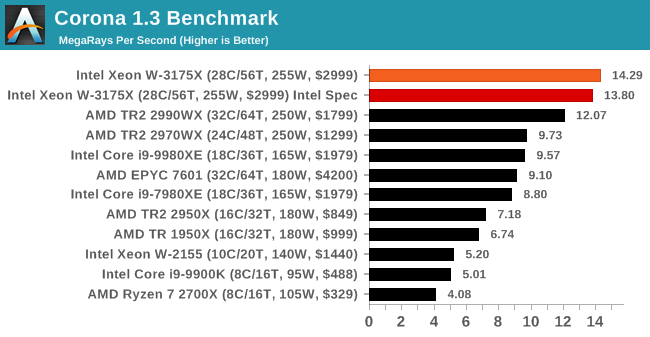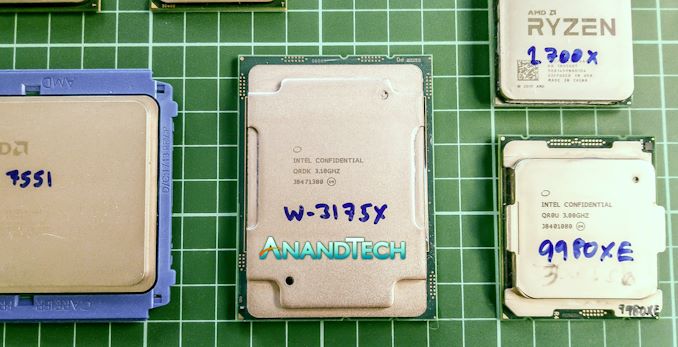The Intel Xeon W-3175X Review: 28 Unlocked Cores, $2999
by Ian Cutress on January 30, 2019 9:00 AM ESTConclusion: Price Makes Perfect
When you buy a system, ask yourself – what matters most to you?
Is it gaming performance?
Is it bang-for-buck?
Is it all-out peak performance?
Is it power consumption?
Is it performance per watt?
I can guarantee that out of the AnandTech audience, we will have some readers in each of these categories. Some will be price sensitive, while others will not. Some will be performance sensitive, others will be power (or noise) sensitive. The point here is that the Xeon W-3175X only caters to one market: high performance.
We tested the Xeon W-3175X in our regular suite of tests, and it performs as much as we would expect – it is a 28 core version of the Core i9-9980XE, so in single threaded tests it is about the same, but in raw multi-threaded tests it performs up to 50% better. For rendering, that’s great. For our variable threaded tests, the gains are not as big, from either no gain at all to around 20% or so. This is the nature of increasing threads – at some point, software hits Amdahl’s law of scaling and more threads does nothing. However, for software that isn’t at that point, the W-3175X comes in like a wrecking ball.

For our graphs, some of them had two values: a regular value in orange, and one in red called 'Intel Spec'. ASUS offers the option to 'open up' the power and current limits of the chip, so the CPU is still running at the same frequency but is not throttled. Despite Intel saying that they recommend 'Intel Spec', the system they sent to us to test was actually set up with the power limits opened up, and the results they provided for us to compare to internally also correlated with that setting. As a result, we provided both sets results for our CPU tests.
For the most part, the 'opened up' results scored better, especially in multithreaded tests, however Intel Spec did excel in memory bound tests. This is likely because in the 'opened up' way, there is no limit to keeping the high turbo which means there could be additional stalls for memory based workloads. In a slower 'Intel Spec' environment, there's plenty of power for the mesh and the memory controllers do deal with requests as they come.
Power, Overclockability, and Availability
Two-and-a-half questions hung over Intel during the announcement and launch of the W-3175X. First one was power, second was overclockability, and two-point-five was availability.
On the power side of the equation, again the W-3175X comes in like a wrecking ball, and this baby is on fire. While this chip has a 255W TDP, the turbo max power value is 510W – we don’t hit that at ‘stock’ frequency, which is more around the 300W mark, but we can really crank out the power when we start overclocking.
This processor has a regular all-core frequency of 3.8 GHz, with AVX2 at 3.2 GHz and AVX-512 at 2.8 GHz. In our testing, just by adjusting multipliers, we achieved an all-core turbo of 4.4 GHz and an AVX2 turbo of 4.0 GHz, with the systems drawing 520W and 450W respectively. At these frequencies, our CPU was reporting temperatures in excess of 110ºC! This processor is actually rated with a thermal shutoff at 120ºC, well above the 105ºC we see with regular desktop processors, which shows that perhaps Intel had to bin these chips enough that the high temperature profile was required.
On the question of availability, this is where the road is not so clear. Intel is intending only to sell these processors through OEMs and system integrators as part of pre-built systems only, for now. We’ve heard some numbers about how many chips will be made (it’s a low four-digit number), but we can only approximately confirm those numbers given one motherboard vendor also qualified how many boards they were building.
One of Anand’s comments I will always remember during our time together at AnandTech was this:
“There are no bad products, only bad prices.”
According to OEMs we spoke to, initially this processor was going to be $8k. The idea here is that being 28-core and unlocked, Intel did not want to consume its $10k Xeon market. Since then, distributors told us that the latest information they were getting was around $4500, and now Intel is saying that the recommended consumer price is $3000. That’s not Intel’s usual definition of ‘per-1000 units’, that’s the actual end-user price. Intel isn’t even quoting a per-1000 unit price, which just goes to substantiate the numbers we heard about volume.
At $8000, this CPU would be dead in the water, only suitable for high-frequency traders who could eat up the cost within a few hours of trading. At $4500, it would be a stretch, given that 18-core on Intel is only $2099, and AMD offers the 32-core 2990WX for $1799 which surpasses the performance per dollar on any rendering task.
At $2999, Intel has probably priced this one just right.
At $2999, it's not a hideous monstronsity that some worried it would be, but instead becomes a very believeable progression from the Core i9-9980XE. Just don’t ask about the rest of the system, as an OEM is probably looking at a $7k minimum build, or $10k end-user shelf price.












136 Comments
View All Comments
johngardner58 - Monday, February 24, 2020 - link
Again it depends on the need. If you need speed, there is no alternative. You can't get it by just running blades because not everything can be broken apart into independent parallel processes. Our company once ran an analysis that took a very long time. When time is money this is the only thing that will fill the bill for certain workloads. Having shared high speed resources (memory and cache) make the difference. That is why 255 Raspberry PIs clustered will not outperform most home desktops unless they are doing highly independent parallel processes. Actually the MIPS per watt on such a processor is probably lower than having individual processors because of the combined inefficiencies of duplicate support circuitry.SanX - Friday, February 1, 2019 - link
Every second home has few running space heaters 1500W at winter timejohngardner58 - Monday, February 24, 2020 - link
Server side: depends on workload, usually yes a bladed or multiprocessor setup is usually better for massively parallel (independent) tasks, but cores can talk to each other much much much faster than blades, as they share caches, memory. So for less parallel work loads (single process multiple threads: e.g. rendering, numerics & analytics) this can provide far more performance and reduced costs. Probably the best example of the need for core count is GPU based processing. Intel also had specialized high core count XEON based accelerator cards with 96 cores at one point. There is a need even if limited.Samus - Thursday, January 31, 2019 - link
The problem is in the vast majority of the applications an $1800 CPU from AMD running on a $300 motherboard (that's an overall platform savings of $2400!) the AMD CPU either matches or beats the Intel Xeon. You have to cherry-pick the benchmarks Intel leads in, and yes, it leads by a healthy margin, but they basically come down to 7-zip, random rendering tasks, and Corona.Disaster strikes when you consider there is ZERO headroom for overclocking the Intel Xeon, where the AMD Threadripper has some headroom to probably narrow the gap on these few and far between defeats.
I love Intel but wow what the hell has been going on over there lately...
Jimbo2K7 - Wednesday, January 30, 2019 - link
Baby's on fire? Better throw her in the water!Love the Eno reference!
repoman27 - Wednesday, January 30, 2019 - link
Nah, I figure Ian for more of a Die Antwoord fan. Intel’s gone zef style to compete with AMD’s Zen style.Ian Cutress - Wednesday, January 30, 2019 - link
^ repoman gets it. I actually listen mostly to melodic/death metal and industrial. Something fast paced to help overclock my brainWasHopingForAnHonestReview - Wednesday, January 30, 2019 - link
My manIGTrading - Wednesday, January 30, 2019 - link
Was testing done with mediation regarding the specific windows BUG that affects AMD's CPUs with more than 16 cores? Or was it done with no attempt to ensure normal processing conditions for ThreadRipper, despite the known bug?eva02langley - Thursday, January 31, 2019 - link
Insomnium, Kalmah, Hypocrisy, Dark Tranquility, Ne Obliviscaris...By the way, Saor and Rotting Christ are releasing their albums in two weeks.
You might want to check out Carpenter Brut - Leether Teeths and Rivers of Nihil - Where Owls Know My Name.